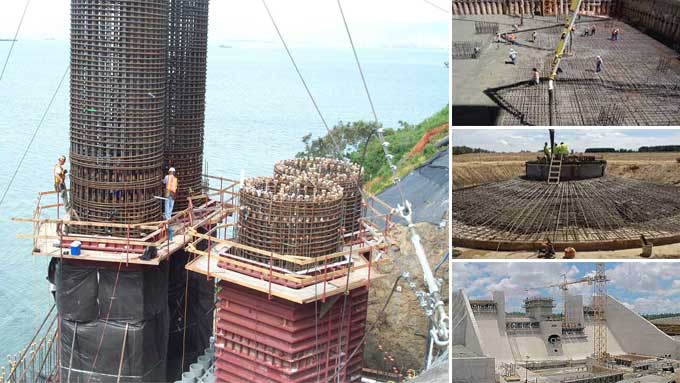
Mass Concrete: Characteristics and composition

According to American Concrete Institute (ACI), Mass concrete can be defined as any volume of concrete, with a combination of dimensions of the member being cast, and boundary conditions. It is to be designed in such a way that they could easily cope with the increase in heat from the hydration of cement and can automatically change its volume to minimize cracking.
The difference between normal concrete and mass concrete can be justified by its thermal behavior. The key objective of Mass Concrete is to create a structure that provides durability for a long period of time.
The outer surface of a particular structure may be a cooling stage but the interior temperature of mass concrete gets higher due to the cement hydration procedure. If the difference between the temperatures of a structure keeps on changing, the structure may get cracked, and the durability of the structure will get reduced.
There are a few factors responsible for the variation of temperature in a particular structure, like the surrounding atmosphere, the size of a structure matters, the type of cement used, and also the materials used in the concrete mixture. It usually used mat foundations like dams, canals, bridges, etc.
Historically mass concrete is used with large structures such as dams, bridges, etc, but however, due to the increased use of fast-paced construction equipment and techniques the mass concrete issues are mainly experienced in old bridges and building structures only.
Characteristics of Mass Concrete
This kind of concrete has characteristic features to resist thermal pressure, chemical reaction, which increases the overall durability and strength of that particular structure.
The process of hydration in mass concrete releases a huge amount of heat. The absence of proper technique to overcome this heat could result in a higher gap in temperature of the interior and exterior surface of the structure and cause excessive thermal pressure and cracks.
This thermal crack provides a passage for air and water to reach the steel, leading to rusting and corrosion. So, it is clear that thermal overheating is a serious issue in case of durability and resistance.
Thus, mass concreting is designed in such a way that the thermal overheating issues get nullified completely. This resistance to thermal heating is the only issue that segregates mass concrete with other concrete.
Composition of Mass Concrete
1. The most commonly used cement brands to form mass concrete according to ACI are, Portland cement, hydraulic cement, blended cement. Portland or any other mentioned cement can be used with pozzolans for the mass concrete mixture. At the time of processing, the batching is performed separately.
2. Pozzolan is an important aspect of mass concrete it restricts thermal heating, also improves durability; also reduces the possibility of alkali reaction. However, the properties of pozzolans may vary so they must be thoroughly kept under surveillance in order to create mass concrete.
3. Ground: Granulated Iron Blast Furnace (GGBS) or slag cement is also required with Portland cement in mass concrete formation. A specific amount of slag cement is to be applied to the mixture. The key work of slag cement is to reduce the temperature by decreasing the rate of hydration. This slag cement also reduces expansion and also improves durability and workability.
4. Before mixing the aggregates grading process should be done which can influence its workability of it. Good quality sand and other materials should be used in mass concrete formation as per the U.S bureau of reclamation.
To learn more, watch the following video tutorial.
Video Source: NOC17 JAN-MAR CE14
5. The water used in the mixture must be free from any kind of chemicals. The chloride content of water should be verified before using to form this Concrete.


